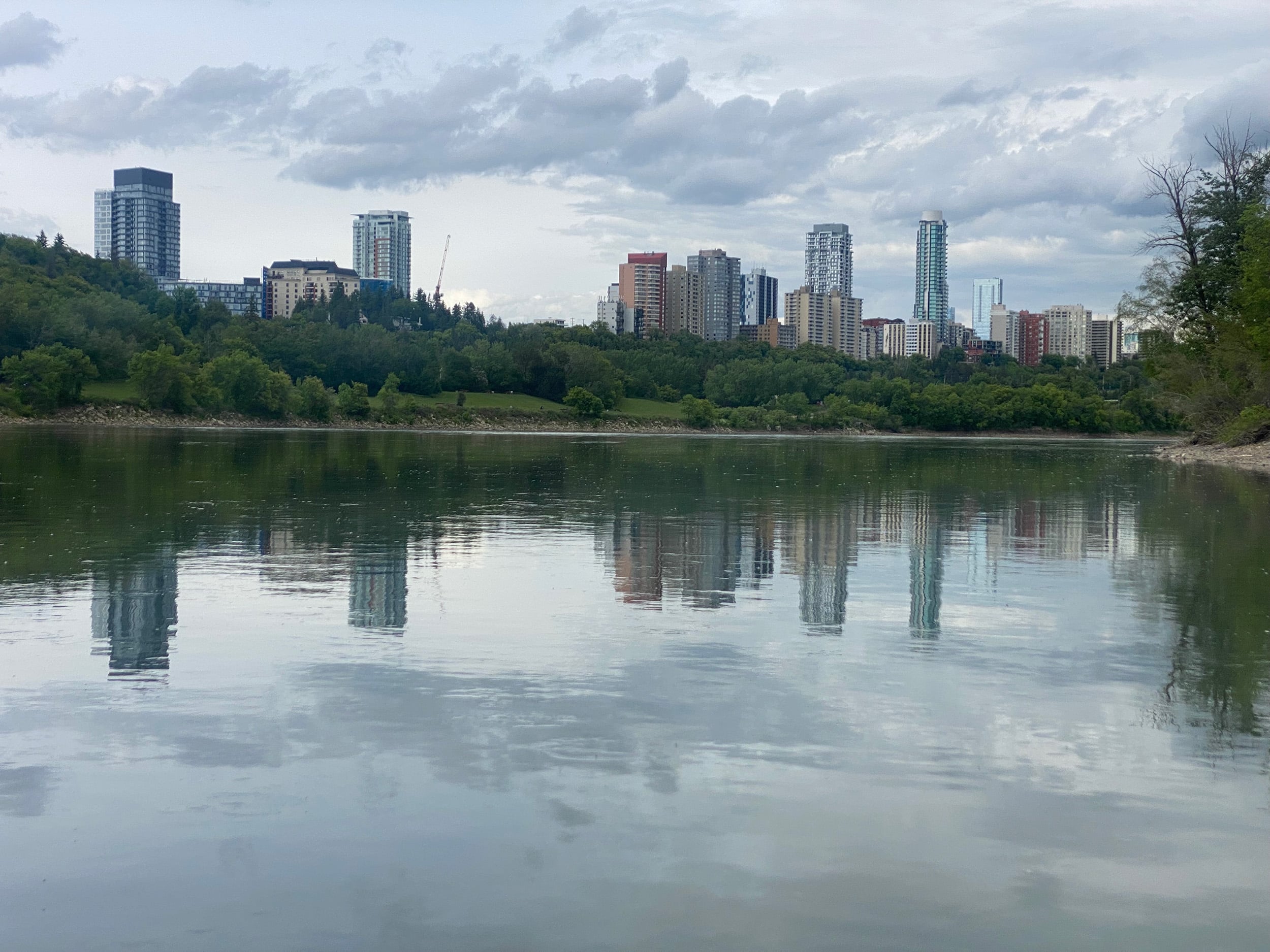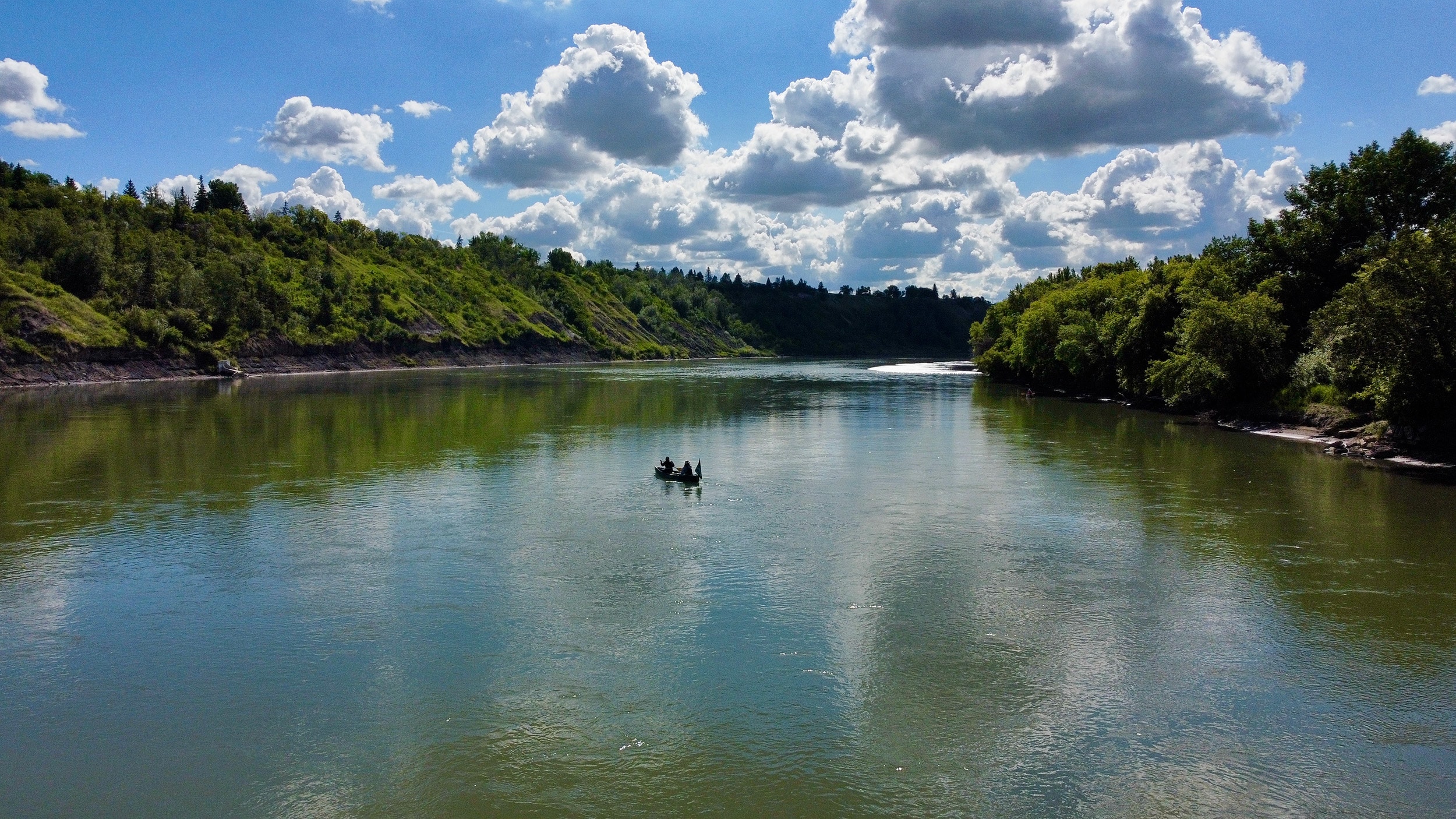Edmonton’s sprawling river valley and ravine system is a local treasure. Not only does it provide critical habitat for at-risk species and act as a wildlife corridor that facilitates the movement of wildlife through the city, it also offers opportunities for Edmontonians to connect with nature and recreate in the parks and throughout hundreds of kilometres of trails.
Nature is the backbone of what makes the river valley special and supports recreational opportunities, cultural uses and everyday enjoyment. The Edmonton river valley, a regional part of the North Saskatchewan River Valley, must be protected, maintained, restored, and properly stewarded to ensure this landscape remains a beloved space where nature can thrive for generations to come.

How can the river valley be better protected?
A National Urban Park in the Greater Edmonton Area that encompasses the river valley between Devon and Fort Saskatchewan would provide a pathway to protect the region’s biodiversity, provide opportunities for sustainable recreation, and contribute to reconciliation with local Indigenous nations through a co-governance park management framework. Unfortunately, the pathway to a National Urban Park has hit a roadblock in the form of provincial legislation, but there are other ways to achieve the protection of Edmonton’s river valley!
Context on the National Urban Park Initiative
The concept of a National Urban Park emerged as a reality in Canada in 2011 when the first National Urban Park received its designation. The Rouge National Urban Park in Toronto was the first of its kind in the country and started a national conversation about creating similar parks in other major urban centres across the country.
Urban centres could see their treasured natural spaces receive additional protections and notoriety and Parks Canada could collaborate with municipalities to assure stable funding and access to expertise. The culmination of these conversations came in 2021 when the federal government announced the National Urban Park Program and allocated funding for the potential creation of six National Urban Parks. In 2025, the federal government renewed its commitment to the National Urban Park program in the Throne Speech, in which it stated the government’s intention to continue designating National Urban Parks.
Edmonton was identified early on as a candidate site for a National Urban Park through the hard work of many local citizens advocating for recognition and long-term protection of Edmonton’s Crown Jewel. Conversations between the City of Edmonton, Indigenous Nations, stakeholder groups, and Parks Canada began.A partners table was created among Parks Canada, the City of Edmonton, the Confederacy of Treaty 6 Nations, and the Metis Nation of Alberta. The Government of Alberta was also invited to participate as a partner, but instead chose to be an “observer”.
However, in 2024, during the pre-feasibility stage of National Urban Park policy creation, the Alberta Legislature passed Bill 204, which explicitly states municipalities are not permitted to collaborate with the federal government with the intent of creating a National Urban Park (NUP). Under Bill 204, municipalities would only be allowed to continue conversations pertaining to a NUP under provincially set criteria, which the province has yet to release. Bill 204 effectively ended all pre-feasibility work and squashed the idea of a National Urban Park in Edmonton for the time being.

Municipal Bylaws are an Opportunity for Strong Nature Protection
As a result of this roadblock, the city must turn to other tools in its toolbox to protect the Edmonton River Valley. A municipality’s most useful tool is its authority to create municipal bylaws which have the potential of meeting, or even exceeding, the environmental protections that would be provided through a National Urban Park program. While municipalities hold power to create lasting protections, Edmonton’s current draft River Valley Modernization Plan misses its opportunity to enact strong, binding ecological protections.
The proposed River Valley Modernization is composed of two parts – the Ribbon of Green and the River Valley Area Development Plan (ARP). The Ribbon of Green acts as a guiding document for the River Valley ARP.
The River Valley ARP is the enforceable bylaw that will govern management of the river valley in the Edmonton region. Unfortunately, the River Valley ARP uses weak language that presents loopholes that can be exploited to allow development in areas where it should not be permitted. As a result, if the ARP is passed as is by City Council, the River Valley will have even weaker protection than it has had since the implementation of the previous bylaw in 1985. This could potentially lead to increased degradation of the River Valley ecology and the loss of more green space.

Policies/Frameworks
- Draft River Valley Modernization:
Ribbon of Green and ARP
An Example of Strong Municipal Protection of Nature: London, Ontario
London, Ontario, offers a compelling example of how strong municipal bylaws can protect ecologically valuable areas in urban settings. The city has designated 22 Environmentally Significant Areas (ESAs) that encompass wetlands, woodlands, aquatic environments and species-at-risk habitat that are essential for biodiversity, climate resilience and public enjoyment. These areas are protected under the city’s official plan, The London Plan, and backed by zoning bylaws that prioritize the ecological function and integrity of these areas above development and recreational pressures.
A major strength of London’s bylaws is the use of clear and binding language throughout their policies. Development is prohibited within ESAs unless it can be demonstrated through detailed environmental assessments that there will be no negative impact on the ecological function of the area. Also, 12 of the 22 ESAs are managed in collaboration with the Upper Thames River Conservation Authority, which provides expertise in ecological monitoring, restoration and stewardship. This partnership allows for long-term ecosystem management and ensures that science is the foundation of ESA ecological management.
This model offers a scalable and locally feasible solution for cities such as Edmonton seeking to preserve urban biodiversity. In the wake of Bill 204 and roadblocks to collaboration with Parks Canada on a National Urban Park, Edmonton could adopt similar tools and tailor them to its unique river valley system. Adapting the current draft River Valley Modernization Plan to be more closely modelled after the London ESA framework would help close existing gaps that could allow environmentally damaging future development and prevent enforceability. Making impactful changes to the River Valley Area Development Plan (ARP) would ensure that development decisions reflect long-term ecological priorities.
How can you take action?
Protecting Edmonton’s river valley is about ecological conservation and defending a vital piece of the city’s identity and history. Whether it be in the form of a National Urban Park, municipal bylaws or other forms of regulation, the river valley needs more permanent and enforceable protections.
While the City of Edmonton may not be able to circumvent Bill 204, it does have the ability and responsibility to advocate for issues that matter to its constituents. City Councilors and Edmonton’s Mayor must hear that the protection of the river valley matters to YOU. The River Valley Modernization Plan is passing before Council for a public hearing on August 18th, which is the last opportunity to advocate for stronger language before it is passed.
Don’t forget: there is also a municipal election on October 20th, 2025 which is another opportunity to bring river valley conservation and protection to the forefront of community discussion. When you vote this fall, vote with the river valley in mind and make sure the candidates for mayor and council know that you care about this issue!
Make a donation
Move conservation forward in Alberta.
Lasting protection for nature and wildlife in Alberta doesn’t happen overnight (although we wish it did)! Your donation fuels our fight for nature. Donate to support CPAWS Northern Alberta’s conservation efforts.
